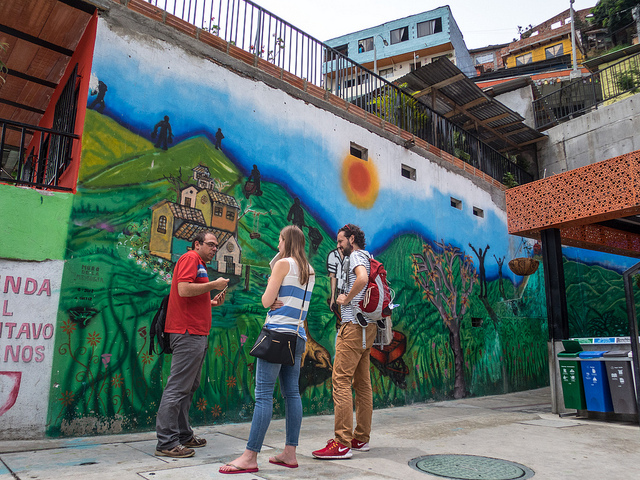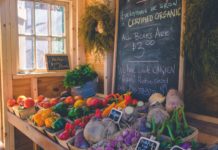
Medellín’s transformation from the most violent city in the world to a global example of urban renewal has been making headlines for years, and especially in light of the recent United Nations World Urban Forum hosted here last month.
To tell the city’s story from the Pablo Escobar-era of the 1980’s to the present day, German-owned Palenque Tours created a half-day tour called Medellín’s History of Transformation.
They recently invited me to check it out, which leads us to a Sunday morning not too long ago.
The Monaco Building
I was picked up at 8:45 AM by David, one of the guides working for Palenque Tours, who also happened to be the one who created the tour. He’s a journalist who’s been living in Medellín for years, after first coming to study during university.
Also in the SUV were two Colombian guides-in-training, both of whom spoke fluent English, and a writer-photographer couple.
Together, we headed off to our first stop of the day, Edificio Monaco in Poblado.
It was here that Pablo Escobar lived with his family for several years at the height of his power. They occupied a two-story penthouse, and the remainder of the space was used to house their private art collection.
The custom-built design is a formidable structure, appearing more like a prison or museum from the exterior than a private residence. It reminded me of the compound Osama Bin Laden built for himself in Pakistan when he went into hiding.
In a 1988 assassination attempt, the Cali Cartel detonated a car bomb early one morning near the parking garage under the building. The resulting explosion caused serious damage to the building, and injured his wife, though Pablo himself was not home at the time.
When the government took control of it, the building was repaired and used as a police station for some time, but it was later abandoned, and has since sat unused for many years.
As David explained, it’s yet another example of the government not knowing exactly what to do with some of the old buildings and residences associated with Escobar.
The decision of what to do with another of his estates, Hacienda Napoles in eastern Antioquia, also took many years. And they still haven’t done much with his former vacation homes in Guatape.
Guards keep constant watch over the empty building, which they believe contains bad spirits. David told us they normally allow his tour groups to enter, but the guard that morning was the exception.
There’s a rumor the building will be turned into a hotel, so perhaps that’s the reason they no longer want to allow tourists to enter.
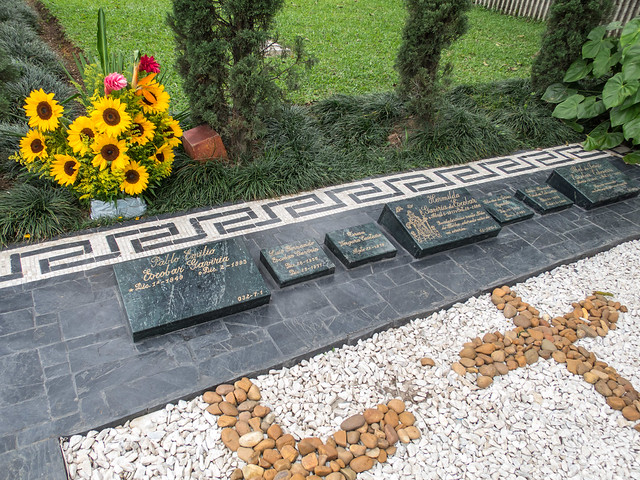
Pablo Escobar’s Family Grave in Itagui
Our second stop was a familiar one, Pablo Escobar’s grave in Itagui.
It was one of the first places I visited in Medellín, and I can still remember my mother’s befuddled response as to why I would do such a thing. For the record, it was out of curiosity, not admiration.
According to David, Escobar’s sister is the caretaker of the family grave, which also includes Escobar’s mother, father, and a lifelong bodyguard.
Unlike the last time I visited, when the main area was all grass, it had since been replaced with white gravel. Two stone crosses are arranged over Pablo and his mother’s grave.
While we were there talking, an older woman came over to pay her respects to Pablo. She said a quiet prayer, and then patted his gravestone a few times.
David asked our Colombian driver why she did this, and he said it was a way to communicate with Pablo’s spirit (like knocking on someone’s front door, I suppose).
The fact that his legacy still engenders goodwill amongst paisas is a topic I struggle with and will never fully understand. We discussed it at length as we drove to our next stop in the heart of Comuna 13.
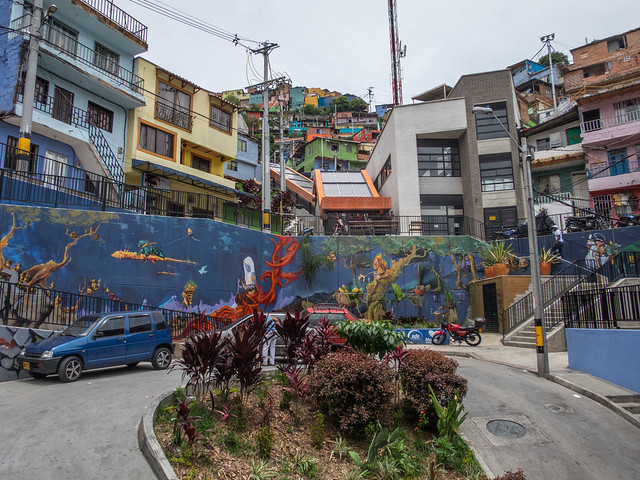
The Outdoor Escalators in Comuna 13
Switching gears from the days of Pablo Escobar, we began to focus on the present day.
One of Medellín’s newest experiments in public transport is a series of five outdoor escalators that extend up a particularly steep hill in Comuna 13.
The escalators received a lot of attention from the thousands of visitors who were in Medellín for the World Urban Forum. I’ll admit, I was curious, yet also slightly concerned about visiting them on my own.
But once our driver dropped us off at the base of the escalators, I suddenly felt relieved. By all appearances, it looked like a regular neighborhood, and a colorful one too.
Beautiful street art covered the walls all along the escalator corridor. The escalators themselves were spotless, and in fine working order.
There were some city employees in uniforms who kept an eye on everyone riding the escalators.
They weren’t police, nor were they armed, but it did feel a little reassuring to know someone was keeping an eye out for riders.
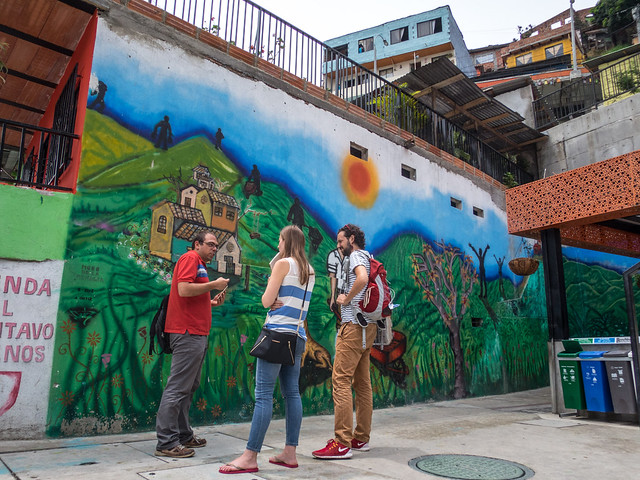
I had no idea there’d be so much artwork, and it appeared much of it was painted in 2012 around the time the escalators first went into operation.
Before the World Urban Forum, the city offered to replace the roofs of any homes painted by their owners. The result in this particular neighborhood is a much more colorful, warm and welcoming atmosphere.
Even the new roofs were painted, which made the view from the top of the escalators that much nicer.
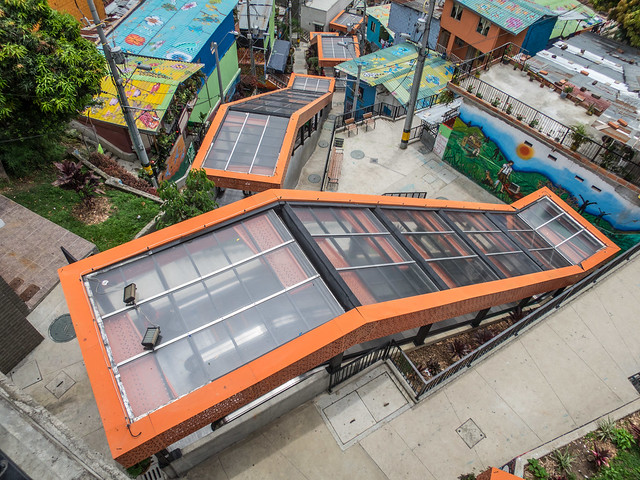
In addition, there were brand new stairs running alongside the elevators, as well as benches.
Space had even been made for plants and flowers.
Details like hanging flower baskets at the top and bottom of each escalator reminded me of the pueblos in Antioquia. It was a very paisa thing to do, and a cute way to dress up the escalators themselves.
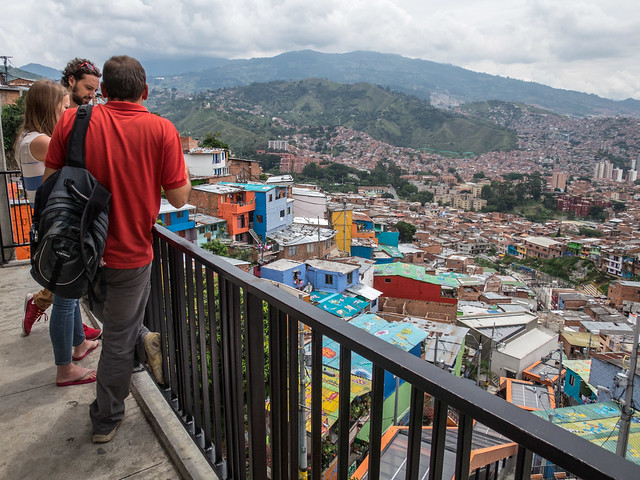
There is a small observation deck atop the last escalator, offering a gorgeous view of Comuna 13. In the distance, it was even possible to see the metrocable running to La Aurora.
Once we’d had our fill of the escalators (a topic I’ll be dedicating another article to soon), we returned to the SUV and were taken to the San Javier metro station.
There, we boarded the metro (cost included in the tour), and made our way to the Hospital station.
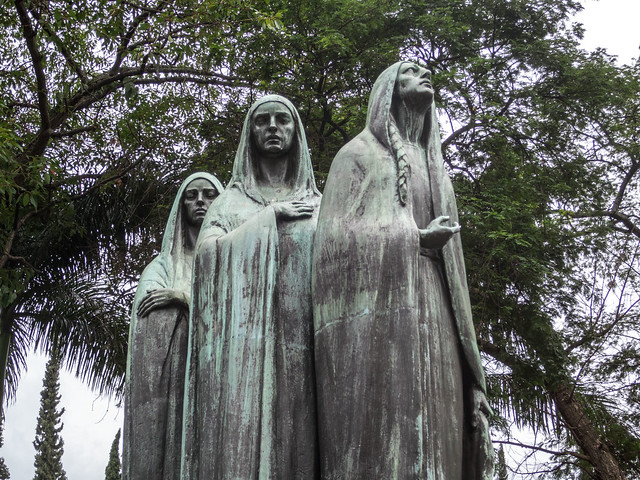
Museo Cementerio de San Pedro
My visit to Museo Cementerio de San Pedro was my second in as many weeks, but I didn’t mind. It’s a site filled with history and interesting stories.
Lucky for us, David had led tours of the cemetery in 2008 for local Colombian school kids. He relayed more than a few interesting stories, and identified the graves of former Colombian presidents and other notable figures.
He showed us The Three Marias, statues that signify stages of grief, starting with denial (far left), and moving on to acceptance (middle), and ending with acceptance (and a look toward God and the Heavens above).
I learned Carlos Gardel was briefly buried in San Pedro after his plane crashed at Olaya Herrera Airport. Within weeks, Argentina reclaimed him, and he was removed from the cemetery. Today, you can still see a headstone for him.
And David also took us to see a grave dedicated to a family of hitmen that worked for Pablo Escobar and the Medellín Cartel. The mother had lost eight sons to the drug violence of that era.
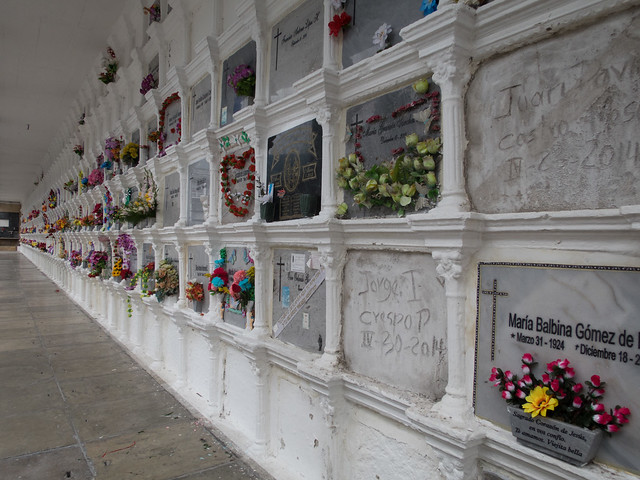
Today, San Pedro is still receiving bodies for burial, though it’s no longer solely the domain of Medellín’s rich and powerful. In fact, it was interesting that David pointed out the ways locals adorn graves today. More than a few had Atlético Nacional stickers on them.
The tour wrapped up with David inviting us to return with him via the metro (also included in the cost of the tour). I parted ways at the Industriales metro stop, exhausted by a very busy five hours.
I may have talked a little too much, but this city continues to find new ways to excite and intrigue me.
Whether you’re visiting, or live here, I highly recommend taking the Medellín History of Transformation. It’s as much about the discussions you have with your guide and fellow travelers as it is about the places you go and see.
________
My tour was provided courtesy of Palenque Tours, which also offers a range of half day and full day tours in and around Medellín, as well as four to seven-day trips around Antioquia, including Choco on the Pacific coast, and Urabá on the Caribbean coast.

